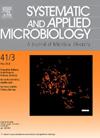Cellulosispirillum alkaliphilum, gen. nov., sp. nov., an obligately anaerobic cellulotrophic member of the phylum Fibrobacterota from soda lakes
IF 4.2
2区 生物学
Q2 BIOTECHNOLOGY & APPLIED MICROBIOLOGY
引用次数: 0
Abstract
Intensive microbiology studies of the past several decades of soda lakes, uncovered a rich functional diversity of haloalkaliphilic microbes driving carbon, nitrogen and sulfur cycles in these unique double-extreme habitats. One of the unexpected finding was a discovery there of aerobic extremely halophilic cellulotrophic natronoarchaea. Yet, little is still known about the identity of the soda lake bacteria able to use native cellulose as growth substrate, except for a single case of an anaerobic clostridium. In this work we present results of phenotypic and functional genomic analysis of an anaerobic bacterium, strain ANBcel5T, enriched from hypersaline Siberian soda lakes with amorphous cellulose as growth substrate. Phylogenetic analysis placed the isolate into the family Chitinispirillaceae in the phylum Fibrobacterota as a new genus and species lineage with the 16S rRNA gene identity and Relative Evolutionary Divergence (RED) to its only known species Chitinispirillum alkaliphilum ACht6–1T of 95.2 % and 0.847, respectively. In contrast, despite obvious morphological resemblance to ACht6–1T, strain ANBcel5T is a narrow cellulose-utilizing fermentative anaerobe fermenting cellulose and cellobiose to acetate, H2 and succinate. It is a moderately salt-tolerant obligate alkaliphile growing optimally at 0.6 M total Na+ as carbonates and pH 9.5. Functional genome analysis of the isolate revealed the presence of multiple genes encoding extracellular endocellulases from the GH families 5 and 9, three sodium-translocating membrane complexes and osmolytes Nε-acetyl-β-lysine and glycine betaine biosynthesis. The bacterium is proposed to be classified as Cellulosispirillum alkaliphilum gen. nov., sp. nov. (DSM 113825 = UQM 41584).
嗜碱纤维素菌属(Cellulosispirillum alkaliphilum, gen. nov., sp. nov.),是碱湖纤维杆菌门的一种专性厌氧纤维素营养菌
对过去几十年的苏打湖进行了深入的微生物学研究,发现了在这些独特的双极端栖息地中驱动碳、氮和硫循环的亲卤碱性微生物的丰富功能多样性。其中一个意想不到的发现是在那里发现了有氧极端嗜盐的纤维素营养钠古菌。然而,除了一种厌氧梭状芽胞杆菌外,人们对能够使用天然纤维素作为生长基质的钠湖细菌的身份知之甚少。在这项工作中,我们介绍了厌氧细菌菌株ANBcel5T的表型和功能基因组分析结果,菌株ANBcel5T富集于高盐西伯利亚苏打湖中,无定形纤维素作为生长基质。系统发育分析结果表明,该分离物属于纤维细菌门Chitinispirillaceae新属和新种,其16S rRNA基因同源性为95.2%,与唯一已知种Chitinispirillum alkaliphilum ACht6-1T的相对进化差异(RED)分别为0.847%。相比之下,尽管形态与ACht6-1T明显相似,菌株ANBcel5T是一种狭窄的利用纤维素的发酵厌氧菌,将纤维素和纤维素二糖发酵成乙酸、H2和琥珀酸盐。它是一种中等耐盐的专性亲碱植物,在0.6 M总Na+和9.5 pH下生长最佳。功能基因组分析显示,该菌株存在多个编码生长激素家族5和9的细胞外内胞酶、3个钠转运膜复合物和渗透酶nε -乙酰-β-赖氨酸和甘氨酸甜菜碱生物合成的基因。该细菌被建议归类为Cellulosispirillum alkaliphilum gen. nov., sp. nov. (DSM 113825 = UQM 41584)。
本文章由计算机程序翻译,如有差异,请以英文原文为准。
求助全文
约1分钟内获得全文
求助全文
来源期刊

Systematic and applied microbiology
生物-生物工程与应用微生物
CiteScore
7.50
自引率
5.90%
发文量
57
审稿时长
22 days
期刊介绍:
Systematic and Applied Microbiology deals with various aspects of microbial diversity and systematics of prokaryotes. It focuses on Bacteria and Archaea; eukaryotic microorganisms will only be considered in rare cases. The journal perceives a broad understanding of microbial diversity and encourages the submission of manuscripts from the following branches of microbiology:
 求助内容:
求助内容: 应助结果提醒方式:
应助结果提醒方式:


